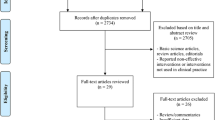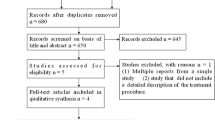Abstract
Background
For almost 30 years, transanal endoscopic microsurgery (TEM) has been the mainstay treatment for large rectal lesions. With the advent of endoscopic submucosal dissection (ESD), flexible endoscopy has aimed at en bloc R0 resection of superficial lesions of the digestive tract. This systematic review and meta-analysis compared the safety and effectiveness of ESD and full-thickness rectal wall excision by TEM in the treatment of large nonpedunculated rectal lesions preoperatively assessed as noninvasive.
Methods
A systematic review of the literature published between 1984 and 2010 was conducted (Registration no. CRD42012001882). Data were integrated with those from the original databases requested from the study authors when needed. Pooled estimates of the proportions of patients with en bloc R0 resection, complications, recurrence, and need for further treatment in the ESD and TEM series were compared using random-effects single-arm meta-analysis.
Results
This review included 11 ESD and 10 TEM series (2,077 patients). The en bloc resection rate was 87.8 % (95 % confidence interval [CI] 84.3–90.6) for the ESD patients versus 98.7 % (95 % CI 97.4–99.3 %) for the TEM patients (P < 0.001). The R0 resection rate was 74.6 % (95 % CI 70.4–78.4 %) for the ESD patients versus 88.5 % (95 % CI 85.9–90.6 %) for the TEM patients (P < 0.001). The postoperative complications rate was 8.0 % (95 %, CI 5.4–11.8 %) for the ESD patients versus 8.4 % (95 % CI 5.2–13.4 %) for the TEM patients (P = 0.874). The recurrence rate was 2.6 % (95 % CI 1.3–5.2 %) for the ESD patients versus 5.2 % (95 % CI 4.0–6.9 %) for the TEM patients (P < 0.001). Nevertheless, the rate for the overall need of further abdominal treatment, defined as any type of surgery performed through an abdominal access, including both complications and pathology indications, was 8.4 % (95 % CI 4.9–13.9 %) for the ESD patients versus 1.8 % (95 % CI 0.8–3.7 %) for the TEM patients (P < 0.001).
Conclusions
The ESD procedure appears to be a safe technique, but TEM achieves a higher R0 resection rate when performed in full-thickness fashion, significantly reducing the need for further abdominal treatment.






Similar content being viewed by others
References
Hermanek P, Gall FP (1986) Early (microinvasive) colorectal carcinoma: pathology, diagnosis, surgical treatment. Int J Colorectal Dis 1:79–84
Allaix ME, Arezzo A, Cassoni P et al (2012) Recurrence after transanal endoscopic microsurgery for large rectal adenomas. Surg Endosc 26:2594–2600
Ohkuwa M, Hosokawa K, Boku N et al (2001) New endoscopic treatment for intramucosal gastric tumors using an insulated-tip diathermic knife. Endoscopy 33:221–226
Tamegai Y, Saito Y, Masaki N et al (2007) Endoscopic submucosal dissection: a safe technique for colorectal tumors. Endoscopy 39:418–422
Higgins JPT, Green S (2010) Cochrane handbook for systematic reviews of interventions version 5.0.2 [updated September 2009]. The cochrane collaboration 2009. John Wiley & Sons, Ltd, Chichester
Moher D, Liberati A, Tetzlaff J et al (2009) Preferred reporting items for systematic reviews and meta-analyses: the PRISMA statement. J Clin Epidemiol 62:1006–1012
Buess G, Kipfmüller K, Hack D et al (1988) Technique of transanal endoscopic microsurgery. Surg Endosc 2:71–75
Kudo S, Rubio CA, Teixeira CR et al (2001) Pit pattern in colorectal neoplasia: endoscopic magnifying view. Endoscopy 33:367–373
Hozo SP, Djulbegovic B, Hozo I (2005) Estimating the mean and variance from the median, range, and the size of a sample. BMC Med Res Methodol 5:13–22
http://www.R-project.org. Accessed 1 Nov 2012
Fujishiro M, Yahagi N, Nakamura M et al (2006) Endoscopic submucosal dissection for rectal epithelial neoplasia. Endoscopy 38:493–497
Onozato Y, Kakizaki S, Ishihara H et al (2007) Endoscopic submucosal dissection for rectal tumors. Endoscopy 39:423–427
Ohya T, Ohata K, Sumiyama K et al (2009) Balloon overtube-guided colorectal endoscopic submucosal dissection. World J Gastroenterol 15:6086–6090
Iizuka H, Okamura S, Onozato Y et al (2009) Endoscopic submucosal dissection for colorectal tumors. Gastroenterol Clin Biol 33:1004–1011
Uraoka T, Ishikawa S, Kato J et al (2010) Advantages of using thin endoscope-assisted endoscopic submucosal dissection technique for large colorectal tumors. Dig Endosc 22:186–191
Ishii N, Itoh T, Horiki N et al (2010) Endoscopic submucosal dissection with a combination of small-caliber-tip transparent hood and flex knife for large superficial colorectal neoplasias including ileocecal lesions. Surg Endosc 24:1941–1947
Takeuchi Y, Uedo N, Ishihara R et al (2010) Efficacy of an endo-knife with a water-jet function (Flushknife) for endoscopic submucosal dissection of superficial colorectal neoplasms. Am J Gastroenterol 105:314–322
Yoshida N, Naito Y, Kugai M et al (2010) Efficient hemostatic method for endoscopic submucosal dissection of colorectal tumors. World J Gastroenterol 16:4180–4186
Saito Y, Uraoka T, Yamaguchi Y et al (2010) A prospective, multicenter study of 1,111 colorectal endoscopic submucosal dissections (with video). Gastrointest Endosc 72:1217–1225
Fusaroli P, Grillo A, Zanarini S et al (2009) Usefulness of a second endoscopic arm to improve therapeutic endoscopy in the lower gastrointestinal tract: preliminary experience: a case series. Endoscopy 41:997–1000
Niimi K, Fujishiro M, Kodashima S et al (2010) Long-term outcomes of endoscopic submucosal dissection for colorectal epithelial neoplasms. Endoscopy 42:723–729
Said S, Stippel D (1996) 10 years experiences with transanal endoscopic microsurgery. Histopathologic and clinical analysis. Chirurg 67:139–144
Cocilovo C, Smith LE, Stahl T et al (2003) Transanal endoscopic excision of rectal adenomas. Surg Endosc 17:1461–1463
Langer C, Liersch T, Suss M et al (2003) Surgical cure for early rectal carcinoma and large adenoma: transanal endoscopic microsurgery (using ultrasound or electrosurgery) compared to conventional local and radical resection. Int J Colorectal Dis 18:222–229
Neary P, Makin GB, White TJ et al (2003) Transanal endoscopic microsurgery: a viable operative alternative in selected patients with rectal lesions. Ann Surg Oncol 10:1106–1111
Schafer H, Baldus SE, Holscher AH (2006) Giant adenomas of the rectum: complete resection by transanal endoscopic microsurgery (TEM). Int J Colorectal Dis 21:533–537
Ganai S, Kanumuri P, Rao RS et al (2006) Local recurrence after transanal endoscopic microsurgery for rectal polyps and early cancers. Ann Surg Oncol 13:547–556
Doornebosch PG, Gosselink MP, Neijenhuis PA et al (2008) Impact of transanal endoscopic microsurgery on functional outcome and quality of life. Int J Colorectal Dis 23:709–713
Guerrieri M, Baldarelli M, de Sanctis A et al (2010) Treatment of rectal adenomas by transanal endoscopic microsurgery: 15 years’ experience. Surg Endosc 24:445–449
de Graaf EJ, Burger JW, van Ijsseldijk AL et al (2011) Transanal endoscopic microsurgery is superior to transanal excision of rectal adenomas. Colorectal Dis 13:762–767
Morino M, Allaix ME, Caldart M et al (2011) Risk factors for recurrence after transanal endoscopic microsurgery for rectal malignant neoplasm. Surg Endosc 25:3683–3690
Allaix ME, Arezzo A, Caldart M et al (2009) Transanal endoscopic microsurgery for rectal neoplasms: experience of 300 consecutive cases. Dis Colon Rectum 52:1831–1836
Barendse RM, van den Broek FJ, Dekker E et al (2011) Systematic review of endoscopic mucosal resection versus transanal endoscopic microsurgery for large rectal adenomas. Endoscopy 43:941–949
Watanabe T, Itabashi M, Shimada Y et al (2012) Japanese Society for Cancer of the Colon and Rectum (JSCCR) guidelines 2010 for the treatment of colorectal cancer. Int J Clin Oncol 17:1–29
Kiriyama S, Saito Y, Matsuda T et al (2011) Comparing endoscopic submucosal dissection with transanal resection for noninvasive rectal tumor: a retrospective study. J Gastroenterol Hepatol 26:1028–1033
Moore JS, Cataldo PA, Osler T, Hyman NH (2008) Transanal endoscopic microsurgery is more effective than traditional transanal excision for resection of rectal masses. Dis Colon Rectum 51:1026–1030
Schlemper RJ, Itabashi M, Kato Y et al (1998) Differences in the diagnostic criteria used by Japanese and Western pathologists to diagnose colorectal carcinoma. Cancer 82:60–69
Disclosures
Alberto Arezzo, Roberto Passera, Yutaka Saito, Taku Sakamoto, Nozomu Kobayashi, Naoto Sakamoto, Naohisa Yoshida, Yuji Naito, Mitsuhiro Fujishiro, Keiko Niimi, Tomohiko Ohya, Ken Ohata, Shinichi Okamura, Shinei Iizuka, Yoji Takeuchi, Noriya Uedo, Pietro Fusaroli, Marco Augusto Bonino, Mauro Verra, and Mario Morino have no conflicts of interest or financial ties to disclose.
Author information
Authors and Affiliations
Corresponding author
Rights and permissions
About this article
Cite this article
Arezzo, A., Passera, R., Saito, Y. et al. Systematic review and meta-analysis of endoscopic submucosal dissection versus transanal endoscopic microsurgery for large noninvasive rectal lesions. Surg Endosc 28, 427–438 (2014). https://doi.org/10.1007/s00464-013-3238-3
Received:
Accepted:
Published:
Issue Date:
DOI: https://doi.org/10.1007/s00464-013-3238-3




